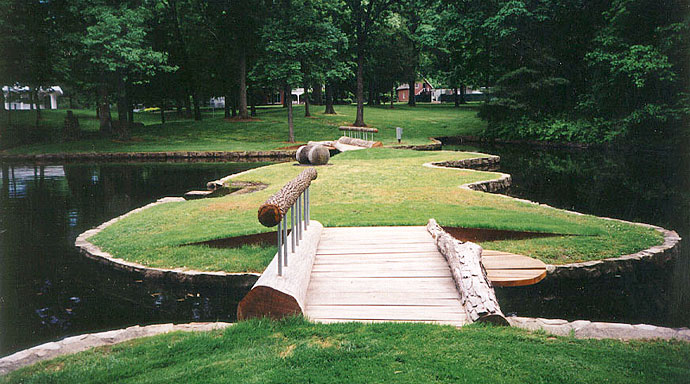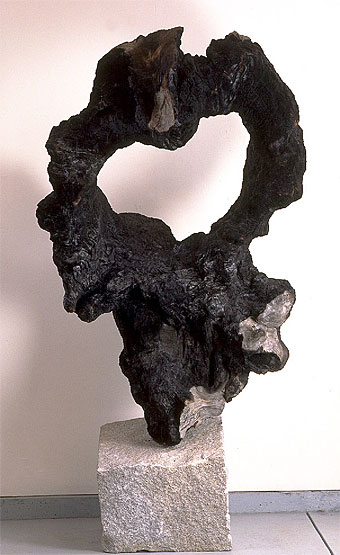
 |
||
| Art to Serve the Spirit Meadowsweet Dairy 
Time decides what is art. Meanwhile, here are some assumptions and insights underlying our work. We believe that art must attempt to manifest the sacred. Environmental art is a mainstream in this effort. For a significant portion of our culture, what is held as sacred is shifting away from toxic religious myths. Reverent attention is turning to the threatened and vanishing wildness from which we arose. How can it be protected and restored? What was the intention of our human ancestors when the caves of Chauvet and Lasceaux were scratched and painted? We don’t think they sought beauty even though they achieved it from our point of view. Later, in many human communities, beauty itself seemed to become a goal and art served it with a passion ranging in cycles from submissive to subversive, back and forth. That cyclical search finds us taking a submissive path in service to the wild. As a motive for art, beauty declines in importance as wildness rises. There is room for both. In a realistic acknowledgment of cultural motives and causes held dear they need each other. Beauty will be refreshed. We have been raised to expect that the earth will provide for those who strive. The perception is reemerging that humans must also work to care for the earth if they wish to survive. Meadowsweet Dairy seeks to express and inspire this insight, and help evolve what art is and what art does. January, 2003 |
While we do most of our own wood, stone and steel work, the Dairy also works with other artists and technical experts. Engineers, biologists and specialty fabricators are important to our process, as are local community groups, funding sources and government agencies. The finished pieces in our studio exhibition space are composed mostly of very interesting natural forms and weathered man-made things which we find in the landscape and transport to the studio. They are transformed with as little intervention as possible. Finding these treasures is thrilling. In years past we have moved lifting gear onto Pacific beaches to haul home fragments of ancient trees left behind by logging, tumbled down flooding rivers, pounded by storm surf and gnawed by fire. We have walked the high country of the Rocky Mountains to find burned and weathered tree fragments and sifted through stone quarry waste piles for elegant, abstract shapes. We wrestle with philosophical issues around our collecting process. Careful as we are to obtain permits and move lightly, there is sometimes a feeling that we are mining and disturbing a natural order. Perhaps this is part of the reason that our collecting has subsided and the site work has accelerated. Now we invest more time into partnering with land and resource managers making sculpture which serves a place and enriches human connection to that place. These are site specific projects. On a remote island refuge we converted a collapsed concrete building into nesting habitat for burrowing seabirds. The structure allows biologists interior access to observe and record behavior and reproductive success. We are currently building bat and white-throated swift habitat in an old silo on another refuge. In the past we assembled a dry stacked stone disc in a desert irrigation reservoir in Utah. It is submerged part of each year as snow melt accumulates and then revealed as the alfalfa consumes water in the summer heat. We have also created bridges in a sculpture park from the harvest of mature hardwood trees at the site to open habitat for birds and to create access to an island in park’s lake. Some of these pieces, though they may be useful, are not in any conventional sense beautiful. How can this be art?
Meadowsweet Dairy is a collaboration between Glenda Griffith, Dan Ustin and Henry Corning working in Corte Madera, California. About half of their time is spent producing sculpture composed of extraordinary natural objects. The other half is devoted to creating site specific works which serve the place in which they are located. |
|
This article was originally published in Landscape & Art, Summer 2003. |
||
Bridges: Installed at The Cedarhurst Sculpture Park of the Mitchell Museum in Mt. Vernon, Illinois. The timber from the museum's forest was used to give access to a pond island.
Djinn: In the collection of the diRosa Preserve, Napa, California, this ancient redwood and white granite piece stands about seven feet tall.
Blind (front view): Installed on Southeast Farallon Island, thirty miles west of the Golden Gate Bridge, San Francisco, California. Within the stacked concrete rubble is a stainless frame holding thirty-two nesting boxes for burrowing sea birds. Biologists crawl inside the structure to monitor the nesting cycles of several species.